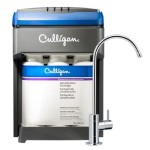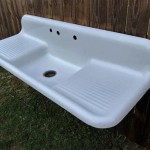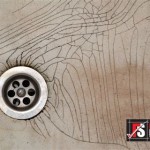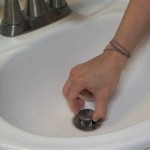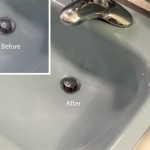Parts For Bathroom Sink Drain
A bathroom sink drain is a plumbing fixture that allows water to drain from the sink into the sewer system. It typically consists of several parts, including the drain body, the drain stopper, the strainer, and the tailpipe.
The drain body is the main part of the drain and is typically made of metal or plastic. It has a threaded connection that attaches it to the sink and a flange that fits over the drain hole. The drain body also has a hole in the bottom that allows water to drain through.
The drain stopper is a small, round device that fits into the drain hole and prevents water from draining out. It is typically made of rubber or plastic and has a handle that allows it to be easily removed and inserted.
The strainer is a small, mesh screen that fits over the drain hole and catches hair and other debris. It is typically made of metal or plastic and has a handle that allows it to be easily removed and cleaned.
The tailpipe is a length of pipe that connects the drain body to the sewer system. It is typically made of metal or plastic and has a threaded connection on one end that attaches it to the drain body and a flange on the other end that fits over the sewer pipe.
In addition to these main parts, a bathroom sink drain may also have other components, such as a pop-up drain assembly, a garbage disposal, or a trap. A pop-up drain assembly is a type of drain that allows the drain stopper to be opened and closed by pressing on the top of the drain. A garbage disposal is a device that grinds up food waste and sends it down the drain. A trap is a U-shaped section of pipe that holds water to create a seal and prevent sewer gases from escaping into the bathroom.
If you are having problems with your bathroom sink drain, it is important to identify the faulty part and replace it. Replacing a bathroom sink drain is a relatively simple plumbing repair that can be completed in a few minutes.
Types of Bathroom Sink Drains
There are several different types of bathroom sink drains available, each with its own advantages and disadvantages. The most common type of bathroom sink drain is the grid drain, which has a series of small holes in the bottom that allow water to drain through. Grid drains are easy to clean and maintain, but they can be easily clogged by hair and other debris.
Another type of bathroom sink drain is the pop-up drain, which has a stopper that can be opened and closed by pressing on the top of the drain. Pop-up drains are more difficult to clean and maintain than grid drains, but they are less likely to be clogged.
A third type of bathroom sink drain is the toe-touch drain, which has a stopper that can be opened and closed by pressing on it with your toe. Toe-touch drains are easy to clean and maintain, and they are less likely to be clogged than grid drains or pop-up drains.
When choosing a bathroom sink drain, it is important to consider the following factors:
- The type of sink you have
- The size of the drain hole
- The style of the drain
- The ease of cleaning and maintenance
- The cost
By considering these factors, you can choose the best bathroom sink drain for your needs.
How to Replace a Bathroom Sink Drain
Replacing a bathroom sink drain is a relatively simple plumbing repair that can be completed in a few minutes. The following steps will guide you through the process:
- Gather your tools and materials. You will need a new bathroom sink drain, a wrench, a screwdriver, and a bucket.
- Turn off the water supply to the sink. This is typically done by turning the handles on the water supply valves located under the sink.
- Place the bucket under the sink to catch any water that may leak out.
- Use the wrench to loosen the nuts that hold the drain body in place. There will typically be two nuts, one on each side of the drain body.
- Remove the drain body from the sink. Be careful not to drop the drain body into the drain hole.
- Clean the drain hole and the flange on the sink. Remove any old sealant or debris.
- Apply a bead of sealant around the flange on the sink. This will help to create a watertight seal.
- Place the new drain body in the drain hole. Make sure that the flange on the drain body is flush with the sink.
- Tighten the nuts that hold the drain body in place. Do not overtighten the nuts.
- Turn on the water supply to the sink and check for leaks. If there are any leaks, tighten the nuts further.
Replacing a bathroom sink drain is a simple plumbing repair that can be completed in a few minutes. By following these steps, you can save money and keep your bathroom sink draining properly.

20 Parts Of Bathroom Sink Drain

Parts Of A Sink The Home

Parts Of A Sink The Home

Parts Of A Sink The Home

Hugedomains Com

How To Install A Bathroom Sink Drain With Faucet Macy Bath Co Ltd

Bathroom Sink Plumbing

Bathroom Sink Popup And Stopper Problems

Bathroom Sink Plumbing Installation Diy Montreal

Bathroom Sink Drain Pipe Is Leaking How To Fix What Check


